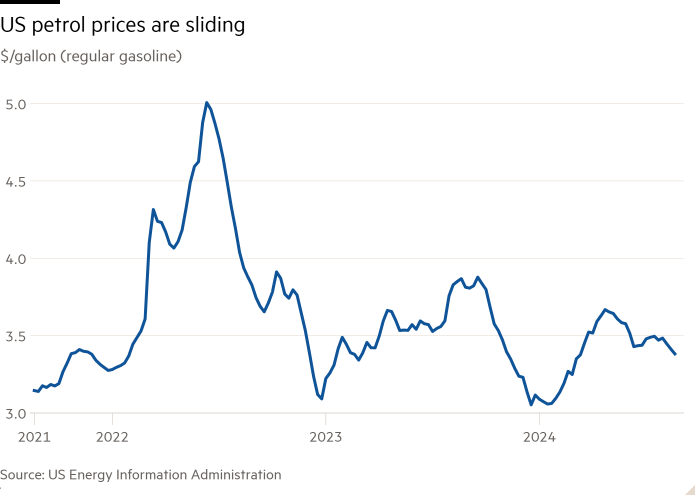
This article is an on-site version of our Energy Source newsletter. Premium subscribers can sign up here to get the newsletter delivered every Tuesday and Thursday. Standard subscribers can upgrade to Premium here, or explore all FT newsletters
Welcome back to Energy Source, coming to you from Houston.
ExxonMobil has issued a bullish forecast for oil demand, suggesting the world’s appetite for crude will remain virtually unchanged at just over 100mn barrels a day by 2050. My FT colleague Jamie Smyth reports on Exxon’s prediction, which comes amid an increasingly fraught debate between fossil fuel producers, climate scientists and policymakers over peak oil.
Across the US, petrol prices are falling. Here in Texas the average cost has slipped below $3 a gallon in recent days.
That is good news for my fuel bill. But it is also good news for Kamala Harris. Nationally, prices are at a nearly six-month low and look set to continue their slide.
In a nation of motorists, election year fuel costs matter — and can have outsized influence in deciding the occupant of the White House. Today’s newsletter dives into what this means for the November election.
Programming note: Energy Source will be off this Thursday, returning Tuesday, September 3.
The political impact of falling oil prices
Prices at the pump are tumbling across the US. For Democrats that is a source of relief; for Republicans it’s a source of frustration.
With exactly 10 weeks to go until Americas go to the polls to pick their next president, motorists are paying an average of $3.35 for a gallon of gasoline, according to the AAA motoring group.
That may be about a dollar more expensive than when Joe Biden took office; it may be well above the average cost of about $2.48 during Donald Trump’s presidency; and as Republicans are quick to point out: it was just two years ago that Biden oversaw record prices of more than $5 a gallon after Russia’s full-scale invasion of Ukraine.
But crucially for vice-president Kamala Harris, the Democratic presidential nominee, the trajectory this year has been downwards. Prices are at their lowest levels since March and look set to keep tumbling as November 5 draws near.
“Pump prices are always exceptionally political because they are a ubiquitously visible cost of transportation upon which modern living standards depend,” Bob McNally, president of consultancy Rapidan Energy and a former energy adviser to George W Bush, told ES.
“While pump prices rocketed to historic highs in mid-2022 and remain well above the Trump year levels, they have been declining from the mid-$3 per gallon range in recent months, partially mitigating the political risk for Democrats ahead of the November elections.”

Americans drive more than any other nation and the country’s gas-guzzling motorists alone account for roughly 10 per cent of global oil demand. What they pay for a gallon of gasoline has an outsized impact on how they vote.
For incumbent presidents, rocketing fuel prices can be a death knell (despite their limited influence over them). Jimmy Carter’s demise was inextricably linked with the panic at the pump that followed the 1970s oil crises. A 2016 study by Stanford academics found that a 10 per cent increase in prices at the pump are correlated with a 0.6 per cent drop in presidential approval.
Higher fuel prices during Biden’s presidency have provided a central attack line for Republicans as they home in on the rampant inflation of recent years in their electoral pitch. That has been blunted lately by the price slide.
Still, Trump pointed to higher prices as he addressed the Republican National Convention in Milwaukee last month. His daughter-in-law Lara Trump, the Republican National Committee co-chair, told delegates: “Many of our fellow Americans don’t know how they’ll pay for their next trip to the grocery store.”
“Trump may be betting that voters remember $5/gallon from the June 2022 peak,” Kevin Book, managing director of ClearView Energy Partners, told ES.
“Nominal pump prices are up roughly $1/gallon since inauguration day, but as a share of real disposable income, they’re right at the five-year average,” Book said.
While many Americans are still feeling the squeeze from prices at the pump, their concerns are receding. The latest FT-Michigan Ross survey found 51 per cent of people ranked it as a top concern, down from 56 per cent three months ago, when the White House was weighing tapping the country’s strategic reserves to bring down prices.
Fundamentally, petrol prices have very little to do with the incumbent occupant of the White House. The biggest influence is the production of crude oil, followed by the level of processing at refineries and price mark-ups by retailers.
Demand has been weaker than expected this summer and will drop sharply when the driving season ends on Labor Day next week, according to the Oil Price Information Service. Meanwhile, the expectation that Opec+ will scale back production cuts in October looks set to increase supply.
“We have seen relatively cheap gasoline in 4Q 2022 and 4Q 2023 but the 4Q of 2024 looks to be cheaper than both of those quarters,” Tom Kloza, global head of energy analysis at OPIS, told ES. “I will be surprised if we don’t see a median price of less than $3/gallon.”
Consumers were less quick to “feel” a decline in inflation than an increase, according to Prashant Malaviya, a marketing professor at Georgetown University. But a drop into the $2-something range would be psychologically significant, with people perceiving it as “low”, he told ES.
Still, a lot could happen between now and November 5 and the slide at the pump may not continue unabated.
Crude prices rose yesterday on reports of production stoppages in Libya. Rising tension in the Middle East or hurricanes on the US Gulf Coast could also quickly halt the trend.
“We have seen this movie before, but the final chapter of 2024 is a bit darker than in the previous years,” said Kloza. (Myles McCormick)
Power Points
Energy Source is written and edited by Jamie Smyth, Myles McCormick, Amanda Chu, Tom Wilson and Malcolm Moore, with support from the FT’s global team of reporters. Reach us at [email protected] and follow us on X at @FTEnergy. Catch up on past editions of the newsletter here.
Recommended newsletters for you
Moral Money — Our unmissable newsletter on socially responsible business, sustainable finance and more. Sign up here
The Climate Graphic: Explained — Understanding the most important climate data of the week. Sign up here